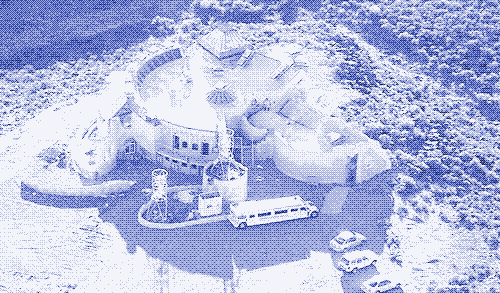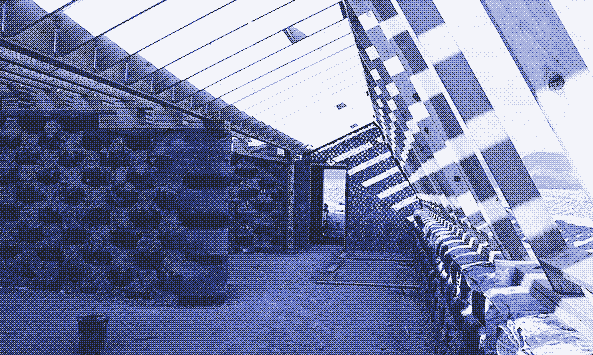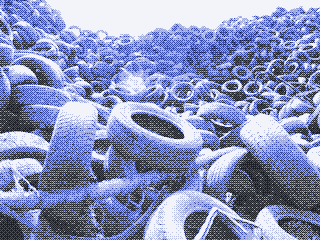
A dirt cheap and 100 percent ecological house that has all the comforts of an ordinary home, without being connected to the electricity grid, waterworks, sewer system or the natural gas network. It does exist, but in most countries, building one is not allowed.
An Earthship is a completely self-sufficient house that has a natural temperature regulation, without the use of a heating system. The building also generates its own electricity, collects and filters its own drinking water and cleans its own effluent water. The house is partly buried into the earth and is constructed mainly with waste materials; car tyres, aluminium cans and glass bottles. This low-tech building approach is ecologically as well as economically advantageous.
This autumn, the British coastal city of Brighton approved the construction of 16 Earthships. It’s the first time that a European city council has given builders the green light to mass construct this radical ecological housing form. In the United States nearly one thousand Earthships have been built, most of them in the desert of New Mexico.
The ecological damage produced by a traditional house is not only the consequence of the energy used during its lifetime, but also through the building materials required to construct it
Earthships are the brainchild of American architect Michael Reynolds, who first put the concept into practice in the seventies, during the first oil crisis. Sharp falling energy prices in the 80’s and 90’s restricted the idea for a long time to mostly anarchistic communities and individuals. Recently however, this revolutionary architecture is slowly gaining credibility in other sections of society. Oil prices continue to climb and uneasiness surrounding global warming grows. Moreover, thanks to 30 years of evolution, many of the initial glitches Earthships faced have been ironed out.

The autonomous nature of an Earthship is not as revolutionary as it was 30 years ago. The technology required to generate energy, filter water and recycle waste water apart from the existing infrastructure has significantly advanced. What makes an Earthship special and interesting these days is that it is mainly built out of waste materials and partly buried into the earth.
Thick walls
The house has very thick walls, with a diameter of around one metre. The walls are not made from concrete or bricks, but from piled up car tyres covered with clay. Every tyre is filled with earth and then tamped down with a sledge-hammer. Depending on the climate, two to three walls are surrounded by a heaped up wall, or built into a slope. Combined with a sun lounge on the south side of the building (the north side on the southern hemisphere) the construction provides a natural heating and cooling system.

The solar heat that enters the house through the large windows is absorbed by the thick walls. The walls have a large thermal mass thanks to the car tyres and the earth – insulation is extremely effective. During the night and on cloudy days, the heat is then slowly released. The same system cools the house in summer, as the surrounding earth and the car tyres are colder than the open air. Thanks to this natural air-conditioning, the inside temperature varies from 17 to 24 degrees all year round.
“No matter how sensible the idea is, building houses with car tyres and aluminium beer cans sounds ludicrous to most politicians”
Scrapped car tyres are the foundations of an Earthship. They are the key to the natural air-conditioning system and they take care of the solidity of the bearing walls. For non-bearing walls, aluminium cans or glass bottles are used. The roof and the veranda are made of wood. While the wood can be re-used, in many instances new wood is preferred. Because the tyres are completely packed in earth, the walls are also fireproof – it is impossible for oxygen to reach the rubber. During a forest fire in New Mexico, the interior of an Earthship was completely destroyed, but the walls were left intact.

Building houses out of car tyres and cans might sound unconventional, but the ecological benefit is so large that the concept deserves to be given some serious consideration. The fact that an Earthship does not use fossil fuels for heating or electricity (and therefore emits no CO2) is not even its most important advantage. By using waste material, the result is even better.
40 million car tyres = 40,000 Earthships
Firstly, great amounts of waste materials can be utilized. In the United Kingdom alone, 40 million car tyres are dumped annually. The project in Brighton uses a thousand tyres for one house, which theoretically means that with the yearly UK supply of dumped tyres, 40,000 Earthships could be built.
Furthermore, one is re-using, not recycling; a much greener option than grinding down tyres to produce speed bumps for example, since the waste is not undergoing an additional industrial, energy consuming process.

Secondly, and even more importantly, by using waste materials, thousands upon thousands of tonnes of building materials could be saved; concrete, mortar and bricks. The ecological damage produced by a traditional house is not only the consequence of the energy used during its lifetime, but also through the building materials required to construct it.
More traditional shapes may help with the general acceptance of this type of building method by the general public
Concrete production is one of the most energy-intensive industrial processes that exist. The sector is responsible for ten percent of global CO2-emissions, which makes it the third highest producer of greenhouse gases (following transport and energy production). Thus, building houses using waste materials (whether the buildings are self-sufficient or not) is an environmental advantage in more ways than one.

Old buildings are often demolished with the argument that replacement buildings have better insulation and therefore consume less energy. What is being overlooked is that both the pulling down of the old house as well as the building of the new house implicates a huge amount of building materials and energy (embodied energy), which completely negate the advantages of better insulation.
And the cost?
Using waste materials does not necessarily mean than an Earthship is cheaper than a traditional house – the homes on offer in Brighton will even be slightly more expensive due to the labour intensive nature of the Earthship (labour is taxed much more heavily than use of energy or materials). Although, once the house is built, the extra investment is quickly recovered as there are no gas, water or electricity bills.
Building an Earthship yourself with some friends could be very cheap, but is time consuming. The largest Earthships in the United States took almost ten years to build. If you build one on your own, the biggest cost would be the purchasing of solar panels and batteries, followed by the large windows, pumps and filters. Waste materials could be delivered for free, as people have to pay to get rid of them.
Unconventional and revolutionary ideas need to be adopted if we want to help prevent a worldwide fight for energy
At the moment, there are only a handful of Earthships in Europe, with half of them built illegally, but the concept following is strong, with various national organisations promoting the idea. The most pressing problem is obtaining a building permit. No matter how sensible the idea is, building houses with car tyres and aluminium beer cans sounds ludicrous to most politicians.

Most Earthships in the US take on an unconventional form. They have fairy-tale like features that remind one of the works of architects like Gaudí and Hundertwasser. But others, like the 16 Earthships being built in Brighton (picture above), hardly look any different from conventional houses. These more traditional forms may help with the general acceptance of this type of building method by the general public.
Built up environments
Until now, most Earthships were built in isolated places, where most people live in built-up urban environments. The problem with the feasibility of an Earthship is the size of the plot on which it is built. This plot is significantly larger than the size of a conventional house.
But the idea is flexible enough to adapt to different situations. When an Earthship is built, earth mounds are formed, which in turn may provide support for another Earthship, and so on. The result would be revolutionary and unconventional. However, in response to the recent warnings from the International Energy Agency, unconventional and revolutionary ideas need to be adopted if we want to help prevent a worldwide fight for energy.